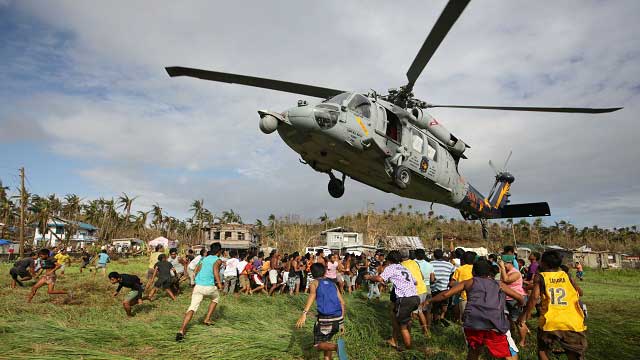SUMMARY
This is AI generated summarization, which may have errors. For context, always refer to the full article.
 It has been difficult to process the destruction of last Friday’s Typhoon Haiyan (Yolanda), which flattened villages across 36 provinces in the Philippines. The United Nations now estimates that 2.5 million people are in need of food aid and close to 600,000 have been displaced.
It has been difficult to process the destruction of last Friday’s Typhoon Haiyan (Yolanda), which flattened villages across 36 provinces in the Philippines. The United Nations now estimates that 2.5 million people are in need of food aid and close to 600,000 have been displaced.
The tragic images that have begun to reach the outside world are flashbacks to the 2004 Indian Ocean tsunami. The scale of the devastation is colossal, and survivors traumatised from the disaster and the loss of their loved ones, homes and livelihoods are desperate for food, water, shelter and medical assistance. Aid workers struggling to reach survivors face severe access challenges due to damaged infrastructure, insecurity and the remoteness of many affected areas. Many survivors remain cut off from assistance. While the full scale of the destruction is not yet known, it is clear that we are facing a massive and complex humanitarian crisis that will require a massive relief and recovery operation.
Saving lives, rebuilding homes and sustaining livelihoods is extremely challenging, especially in large-scale disasters. The international community struggled to rebuild Haiti after the 2010 earthquake and hundreds of thousands are living in camps to this day. In Aceh and Nias, houses and infrastructure were successfully rebuilt after the tsunami, but insufficient support was provided for sustainable livelihood recovery.
These past experiences of large-scale disaster responses can offer the Philippines, and those responding to the crisis, some lessons to best support the millions who have lost loved ones, homes and livelihoods.
Leadership is needed on the ground, with the people
The most critical element of any post-disaster relief and recovery operation is leadership – and that leadership must be as close to the ground as possible. This means that, while international assistance is urgently needed, the response must be firmly under the leadership of the Government of the Philippines, and it must involve the people affected by the typhoon.
Strong government leadership and coordination, combined with community-driven recovery, was key to the Aceh-Nias reconstruction process; the lack of both was among the biggest obstacles to the post-earthquake recovery effort in Haiti. Instead, the country was overrun by international aid agencies, many of whom had little understanding of the country’s social, political and cultural context. So while the focus now is on responding as quickly as possible to urgent humanitarian needs, we must recognise from the start that, without local leadership, both from the government and the communities, the response will not be sustainable, effective or beneficial for those affected by the crisis.
Don’t let humanitarian response dominate recovery

After immediate needs subside, people will want to rebuild their homes and livelihoods as quickly as possible, and should be helped to do so. Failure to do this played out in the worst possible way in Haiti after the earthquake. Shelter was an incredible challenge – with nearly 300,000 houses damaged or destroyed, over a million and a half people ended up living in tented camps, many of them for years. Land rights in the country were complex and challenging, but the majority of aid agencies opted to provide their own solutions and locate people in camps, or provide expensive prefabricated ‘transitional’ shelters – that were not permanent homes by nature – rather than a more concerted effort supporting people to return quickly to their neighbourhoods and rebuild their homes themselves. To this day, hundreds of thousands of Haitians are still living in camps.
In Aceh, the government ensured that any agency working on shelter for those affected by the tsunami was obliged to construct homes – permanent solutions for those rendered homeless. However, while many homes were built or rebuilt, aid agencies were overwhelmed by the amount of building contracts they had to manage, which took time and capacity from other areas of response. There were also few options for supporting people to rebuild their homes themselves, either through grants or loans, which would have ultimately been a more sustainable and cost-effective way to provide people with the homes most appropriate for their needs.
Recovery efforts in Indonesia were also dominated by a focus on housing and infrastructure, but livelihoods recovery received inadequate support. After the reconstruction operation, many people had new homes, but had not regained their sources of income. Livelihoods and job creation are essential elements of recovery and are ways to kick-start economies hard hit by disasters. But livelihood recovery takes quite a lot of time and, partly because of tight funding time-frames and donor pressure to spend funds quickly, livelihood programmes tended to be short-term after the tsunami.
As we saw in Indonesia after the tsunami, such crises inevitably leave deep and indelible marks on the lives of the survivors, and future generations to come. This can be positive or negative; Typhoon Haiyan can be remembered as a devastating tragedy that many communities were never able to recover from – or one that was overcome by supporting the people and government of the Philippines to rebuild lives and livelihoods, reflecting the needs, priorities and concerns of those affected by the disaster.
Dr. William Sabandar is the Special Assistant to the Head of the Presidential Delivery Unit of the Government of Indonesia and former Director for Nias at the Government of Indonesia’s Executing Agency for Rehabilitation and Reconstruction (BRR) of Aceh-Nias 2005-2009. He also served as Special Envoy for the Secretary of ASEAN for Post-Nargis Recovery in Myanmar from 2009-2010.
Lilianne Fan is a Research Fellow at the Humanitarian Policy Group of the Overseas Development Institute in London. She has previously served as Housing, Land and Property Coordinator in the IASC Shelter Cluster in post-earthquake Haiti, Recovery Adviser to the Special Envoy for the ASEAN Secretary-General for Post-Nargis Recovery in Myanmar and Senior Policy Coordinator for Oxfam in post-tsunami Aceh, Indonesia.
Add a comment
How does this make you feel?
There are no comments yet. Add your comment to start the conversation.